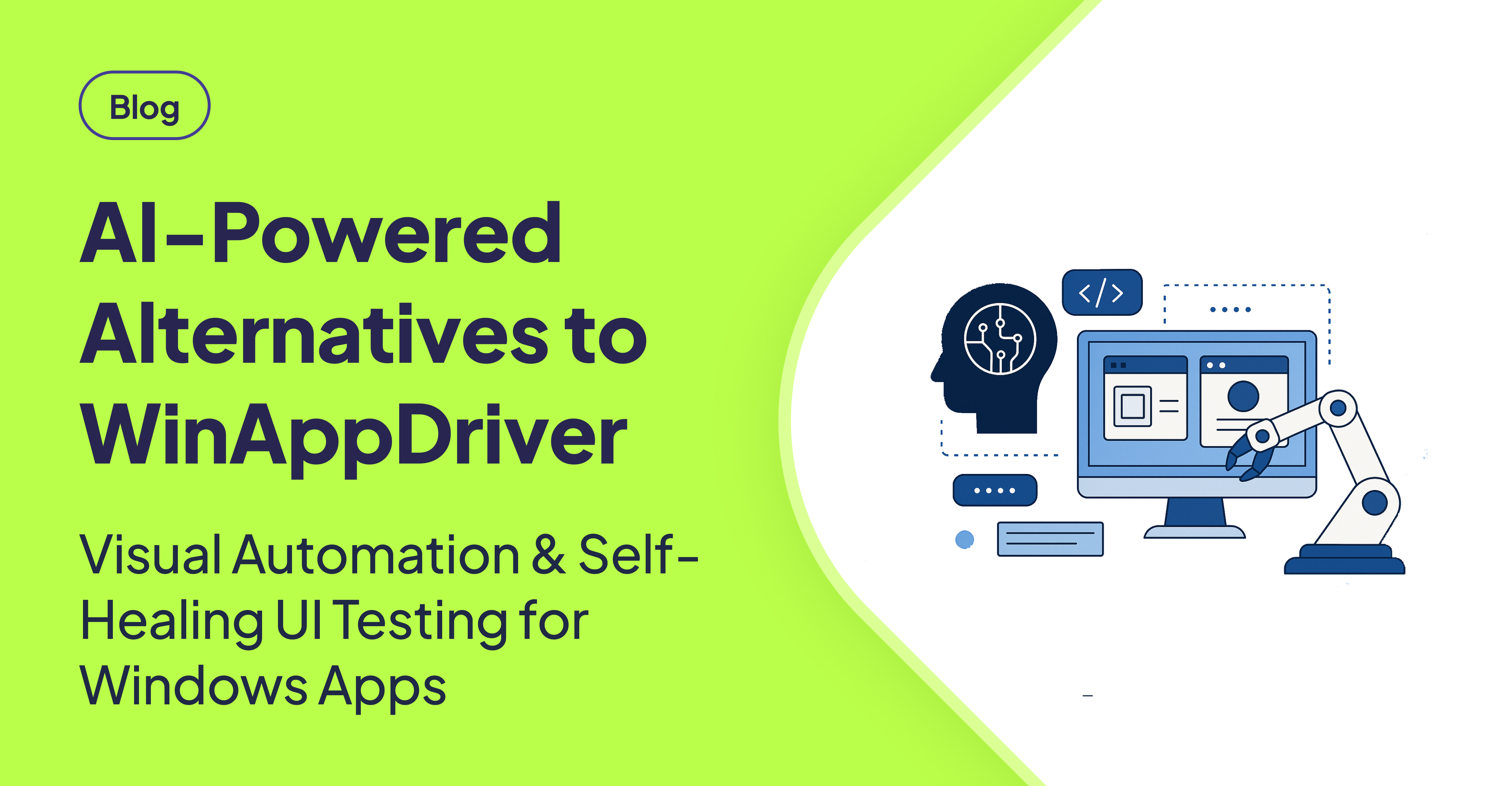What Are the Best Alternatives to WinAppDriver for Windows Automation?
AI-powered tools offer a more flexible and resilient approach to Windows application automation than WinAppDriver. Solutions like AskUI leverage visual recognition and prompt-based interfaces to simplify test creation and reduce maintenance, especially across diverse UI frameworks.
Why Do QA Teams Seek Alternatives to WinAppDriver?
While WinAppDriver has served many QA teams, its limitations often hinder automation scalability and flexibility.
1. Platform and Framework Limitations
- Restricted Framework Support: WinAppDriver primarily supports Microsoft-specific UI frameworks such as:
- UWP (Universal Windows Platform)
- WPF (Windows Presentation Foundation)
- WinForms
- MFC (Microsoft Foundation Class)
- Custom UI Challenges: Applications using custom or hybrid frameworks frequently face compatibility issues with WinAppDriver.
2. Limited Cross-Platform Support
- Windows-Only Scope: WinAppDriver is confined to Windows 10 (22H2) and later, offering no native cross-platform automation capabilities.
- Modern Enterprise Needs: Many QA teams require automation that spans across Windows, macOS, Linux, web, and mobile platforms.
3. Complex Element Identification
- UIA and MSAA Dependence: WinAppDriver relies on UI Automation (UIA) and Microsoft Active Accessibility (MSAA), which struggle with:
- Deeply nested elements
- Dynamically generated components
- Legacy or non-standard UI libraries
- Frequent Workarounds: XPath selectors and custom scripting are often needed to stabilize tests, increasing complexity.
4. High Maintenance Overhead
- Brittle Test Scripts: Any minor UI change (label, position, structure) can break existing test scripts.
- Constant Rework: QA teams spend significant time maintaining tests rather than building new coverage or improving quality.
How Do AI-Powered Automation Tools Solve These Problems?
Modern AI automation platforms redefine Windows application testing by removing many of WinAppDriver’s constraints.
1. Visual Recognition Over Code Selectors
AI vision models detect on-screen elements visually, similar to how humans interact with software:
- Identify buttons, menus, and forms regardless of UI framework.
- Eliminate dependency on fragile object hierarchies or selectors.
- Handle custom-drawn or dynamically generated components seamlessly.
AskUI’s approach to visual automation follows this exact principle, enabling teams to work directly with the rendered UI instead of relying on internal code structures.
2. Cross-Framework Compatibility
AI tools operate independently of the underlying technology stack:
- UWP, WPF, WinForms, MFC, Electron, JavaFX, and custom UIs supported out-of-the-box.
- No need for separate drivers or integrations.
3. Broader Platform Coverage
Many AI-powered solutions enable automation across:
- Windows 10, 11, and legacy versions
- macOS and Linux environments
- Web and mobile interfaces
- Virtual desktops (VDI), Citrix, and remote desktop sessions
ℹ️ Industry Insight:
While many AI tools advertise cross-platform capabilities, the actual maturity of macOS, Linux, and VDI support varies significantly by vendor and implementation.
4. Democratizing Test Automation
AI automation empowers non-developers to contribute:
- Prompt-Based Test Creation: Use natural language or visual prompts to define test steps.
- No-Code Interfaces: Business analysts and manual testers can build and execute automated tests.
- Faster Onboarding: Reduced learning curve for non-technical team members.
ℹ️ Industry Insight:
The accessibility for non-programmers largely depends on the tool's UI/UX maturity and internal training resources.
5. Self-Healing Capabilities
AI models adapt to UI changes automatically:
- Recognize relocated or renamed UI elements.
- Minimize script failures after minor interface updates.
- Lower ongoing maintenance costs.
AskUI’s adaptive AI engine focuses heavily on self-healing logic to minimize script failures caused by frequent UI changes.
ℹ️ Industry Insight:
Self-healing effectiveness improves with training data volume and system complexity. In highly dynamic UIs, manual review may still be required.
AI vs. WinAppDriver: Quick Comparison Table
Who Should Consider AI-Powered Automation?
AI-powered tools are ideal for:
- QA Managers seeking lower maintenance overhead
- Test Automation Leaders expanding coverage across multiple platforms
- QA Engineers frustrated with fragile scripts and custom framework limitations
- Business teams wanting to actively participate in automation
Companies adopting AskUI often fall into these exact categories, benefiting from increased automation coverage and reduced maintenance costs.
Related Resources
- What Is Agentic AI? And How It’s Revolutionizing Test Automation
- AI Desktop Automation for Smarter QA & RPA Workflows
- Top 10 Agentic AI Testing Tools for QA Engineers in 2025
Frequently Asked Questions (FAQ)
How do AI-powered automation tools handle accessibility compliance testing?
Currently, most AI-powered automation tools focus on UI interaction rather than full accessibility validation. While visual AI can help detect visible issues like missing labels or inconsistent layouts, comprehensive accessibility testing (e.g., WCAG 2.1, ARIA roles, screen reader compatibility) still requires dedicated accessibility testing tools.
Can AI-based automation tools integrate with CI/CD pipelines?
Yes. Many AI automation platforms provide REST APIs, CLI tools, or native plugins that enable integration with CI/CD systems like Jenkins, GitLab CI, and Azure DevOps. However, integration depth and stability may vary depending on vendor maturity.
How do AI automation platforms compare to RPA tools for desktop automation?
AI-powered test automation focuses on dynamic UI validation, complex workflows, and adaptive test maintenance. RPA tools are typically used for rule-based, repetitive business process automation. While both can automate desktop applications, AI platforms are generally more suitable for QA teams testing rapidly changing applications.
Can AI-powered tools automate legacy desktop applications on remote virtual environments?
Yes. Many AI-powered solutions support automation within VDI, Citrix, and other remote desktop environments by visually interacting with screen-rendered content. However, reliability depends on factors like screen resolution consistency, network latency, and image rendering quality.
Key Takeaways for QA Leaders
AI-powered automation eliminates many of WinAppDriver’s technical constraints, offering broader framework support, easier maintenance, and accessibility for non-developers. Organizations looking to modernize their automation stack should actively evaluate AI-driven solutions as part of their QA strategy. Platforms like AskUI offer practical, production-ready options for teams ready to make this transition.





.png)


